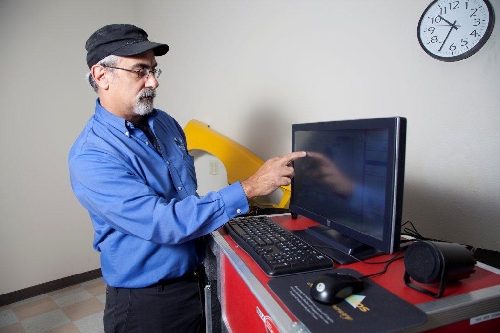Learning to paint, weld, drive in virtual reality
It was the smell of fumes in the automotive building as students learned to paint vehicles each semester that prompted John Ventura, director of the College of Southern Nevada's Automotive Program, to search for a virtual solution.
With the assistance of federal Perkins funding and the Southern Nevada Franchised New Car and Truck Dealers Association, Ventura was able to purchase a state-of-the-art instructional tool that trains painters and coaters with no fumes. The technology, called SimSpray, allows students to paint in a virtual reality.
"I think it's going to save a lot of paint," automotive student Travis Fontanilla said. "It's a lot of fun."
SimSpray includes a virtual reality helmet and spray gun that hooks up to a portable computer, where the instructor can watch as students basically play a video game in which they seek to beautify virtual fuel tanks and fenders. It is one of several new virtual simulators at the college that are creating unique learning experiences that enhance students' experience.
The college also uses a virtual simulator for welding and in the motorcycle training program.
"CSN is the only college in the nation using this virtual motorcycle training program as a stand-alone class. Riders experience and respond to a variety of on-screen scenarios, as they travel along virtual streets and highways," said Roger Fox, who heads the popular training program.
Just like the arcade ride, the simulator allows the student to sit on a bike and ride on virtual roads through a variety of traffic and weather conditions. Students can see themselves crash from multiple perspectives while the instructor analyzes their performance and provides guidance. The program also provides data that will help the student improve.
The virtual welding and vehicle paint sprayer programs also measure students' performance so instructors can track their progress throughout the semester.
"This shows a student's efficiency and consistency and we can track a student's progress over the semester as they improve. A body shop will charge $65 to $100 an hour for a paint job and we're training experts that will make every minute count," Ventura said.
If students mess up, he noted that they won't have to spend hours sanding down the vehicle to get back to the metal base.
"And there are no hazardous VOC (volatile organic compound) emissions, so we're reducing our environmental impact and our expenses," Ventura said.
Beginning students this fall are learning to paint on two SimSprays, Ventura said. Those with more training will still work with real paint on real vehicles, but can "warm up" using the virtual program. He estimates the new technology will save the college at least $7,000 in the first semester on paint and materials.
The best part about the technology, Ventura said, is that he gets to spend one-on-one time training students. In the paint lab, students and instructors are required to wear protective suits and face masks along with other safety paraphernalia that inhibit communication.
Fontanilla gave the SimSpray a try this summer as Ventura guided him through the selection of pressure and color. He taught the novice painter to count as he swayed back and forth in a tai chi motion with the gun, covering a motorcycle part with hot pink. Then, using a computer, they went over Fontanilla's performance to see how thick and consistent his coats were and where he left runs.
"You need to bend your knees, buddy," said Ventura, who equates painting to dancing. "I teach them to count to keep the strokes the same all the way across for equal distribution (of paint.)
"Everyone has their own rhythm."

















